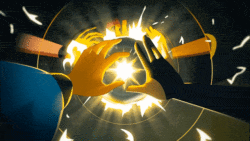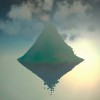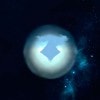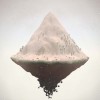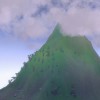Animation director David O’Reilly recently launched his first game, “Mountain,” and while it’s been picked up by loads of press outlets both mainstream and niche, no one has been able to pin down exactly what it’s all about.
Calling “Mountain” a “game” is a bit misleading. Those air quotes aren’t derisive or dismissive. They’re meant to point towards the project’s enigmatic nature.
Like much of O’Reilly’s work, “Mountain” upends expectations, refusing to fit into preexisting categories. As soon as the traditional tools of game criticism are applied to it, it deflects them like scalpels glancing off glass. Looking at it through the lens of animation isn’t much help either.
And yet, it has hypnotic power over many of its… users? players? viewers?
Aesthetically, “Mountain” fits within O’Reilly’s glitchy, low-poly universe. The game sequences he created for Spike Jonze’s “Her,” the episode of Adventure Time he directed and his short films all share a stripped down, intentionally “un-glitzy” approach to CG animation that is O’Reilly’s hallmark.
I asked Mr. O’Reilly a few questions about “Mountain,” and he was kind enough to share some (not all) of his thinking behind the project.
Q&A with David O’Reilly
So for the uninitiated, what is Mountain?
Mountain is an ambient game where you play a Mountain.
And now the obvious question: Why did you make it?
I will avoid being explicit about why, but I’ll say when you get to the essence of how animation functions, beyond design and storytelling, it comes down to emotional projection (at least for me). I think it’s the same with games – but they allow so many other ways of exploring it. I’m interested in finding new ways of feeling something, or getting to a mental place that you can’t arrive at with language or thought.
I can see from your Twitter feed that you’ve been following some of the press you’ve gotten for the title.
I want to ask first if you have a theory about why you’re getting so much press. There are dozens of indie games released each day that go unnoticed in the press, but you’ve been picked up most of the major players. Any idea why that might be?
When it was announced at Horizon – the press had this angle that I made the game in Her and now have a real game, but since it’s release it seems to have entered into another discussion about what category it fits into. Both approaches are kind of avoiding any real enjoyment of the thing itself, it feels like a struggle to put it into context more than anything else.
I’d like to ask you to respond to Michael McMaster’s Medium post, in which he says:
“Mountain is not a text. It shouldn’t be treated as one. Mountain is best understood as an exercise in form — it’s a small, contained work that depicts and explores a mountain as an object. It’s not aspiring to anything greater. It’s iconography. This is fine.”
What do you think about the assertion that The Mountain is not a “text”?
I think this is one interpretation, and it’s well rounded, but I don’t agree or disagree. I think everything is just what it is, and even (or often) the creator of something can’t necessarily be trusted with what they say about it.
I remember the opening you created for Pictoplasma in 2009, “When You’re Smiling.” One reading of that project was as a critique of the kind of character work that is often heralded at Pictoplasma: the super cute, “kawaii” approach to character design.
Your work, in my opinion, often upends expectations. More to the point, you seem to use viewer expectations as material with which to work. Mountain feels like it was created in a similar spirit: we approach it as a game, but it’s not a game. We approach it as art, but it’s not art. The thing that keeps me “playing” Mountain is the way it ignores/perverts/destroys my expectations.
With my own work, I always feel there’s no point unless theres new ideas to try, even though they’re more likely to fail. I don’t think about these things being subversive as much as just trying new ideas and seeing where they go.
It seems to me that you’re a busy guy. How did you find time to make Mountain? How long did it take?
I think being busy is mostly an impression. I often feel like I can’t get enough done and everything happens in slow motion. It’s hard to say exactly how long Mountain took, as it’s been happening around a lot of other projects.
On the technical side, how hard was it learning Unity? Did you have help?
I’m still learning Unity. Earlier in the year I had an injury which grounded me for a few months, so I just sat down and started playing with it. I had help from Damien Di Fede, who is a handsome fellow who did all the code in the game.
The sound design is a huge part of the experience. Was it difficult creatively directing sound design that is generative in nature?
My job with sound is to think in the boldest terms of texture and mixing, I don’t have the language or ability to do it myself. Damien brought so much experience to that side of it.
Anything I left out that you want to add?
Just that we’re still working on it. There will be updates to every platform soon that address performance issues for people running it on pre 2013 hardware. A few other things down the road.
Post script
In case you’re curious: O’Reilly promises the game does have an ending. It takes roughly 50 hours of game time to reach.
(I have yet to witness it. And if the gameplay so far is any indicator, witnessing is exactly the mode of engagement I should expect.)


